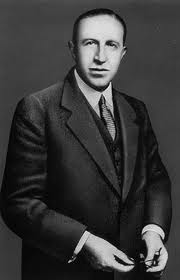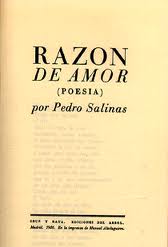Life & works of Pedro Salinas
Pedro Salinas was a Spanish poet, the best love poet of the Generation of '27. His most famous works are the trilogy he wrote on relationships, which he dedicated to a North American student with whom he fell in love. Pedro Salinas spent most of his life teaching from university to university, going as far as Boston.
Pedro Salinas - Life

Pedro Salinas was born in 1891 in Madrid. He studied Arts, and his life was dedicated almost entirely to teaching in the University. His teaching activity began in La Sorbonne from 1914 to 1917, where he worked as a Spanish reader. He obtained his PhD in La Sorbonne and grew to love the works of Marcel Proust.
In 1914 he married Margarita Bonmatí Botella, who was originally from Alicante. Pedro Salinas wrote her a love letter each day and that collection was published with the title "Cartas de amor a Margarita" (1912-1915) by his daughter, Soledad Salinas. He also had a son, Jaime, who was also a writer.
Un 1918 Pedro Salinas works as a professor in the University of Seville and between 1922 and 1923 he taught in Cambridge; from 1923 to 1925 he did so in Murcia. In 1925 he published a modernized version of the "Cantar del Mio Cid". In 1926 he started to work in the University of Madrid where in 1932 he founded the magazine "Índice Literario" to account for the Hispanic literary news. Between 1928 to 1936 he was investigator in the Centro de Estudios Históricos, where he was in charge of the section of modern literature.

He was named professor in the Escuela Central de Idiomas and general secretary to the Universidad Internacional de Verano de Santander where in 1932 he met the North American student Katherine R. Whitmore. To her he dedicated his poetic trilogy "La voz a ti debida", "Razon de amor" and "Largo lamento". The affaire went on after she returned to the US, but when she came back Salina's wife found out and tried to committ suicide. The relationship went on for a while until 1939 when Katherine married a colleague of hers and severed all contact with Pedro Salinas. He continued to write to her until 1947.
Pedro Salinas spent some summers in Alicante, where his wife had a family home. He was a great friend of Jorge Guillén and of Miguel Hernández. The Spanish Civil War broke out while he was in Santander and he left for America to teach in Wellesley College and in the University of Johns Hopkins, in 1943 he started to work in the University of Puerto Rico, but returned to Johns Hopkins in 1946. Pedro Salinas died in Boston in 1951.
Pedro Salinas - Works
Pedro Salinas defines poetry like a probe in reality, "an adventure towards the absolute" as he put it. He distinguishes 3 elements in his creation: authenticity, beauty and wit. In Pedro Salinas, feeling and intelligence bond in a peculiar way: each permits the examination of the other. He prefers short verses and almost never uses rhymes. The apparent simplicity of his verses made Lorca call them "prosias" (a mix of prose and poetry).
The literary work of Pedro Salinas can be divided in three periods.
Initial stage (1923-1932)
This stage is marked by the influence of the pure poetry of Juan Ramon Jimenez, and also by the Futurist and Ultraist vanguards. The idea of poetic depuration and perfection, and the relevancy of the topics related to love outline his plenitude period. Important works in this period are "Presagios" (1923), "Seguro azar" (1929) y "Fábula y signo" (1931).
Plenitude stage (1933-1939)

This stage is formed by the love trilogy dedicated to Katherine R. Whitmore: "La voz a ti debida" (tells the story between two lovers, from beginning to end), "Razon de amor" (examines what is left of love after it ends. The passion and pain of the separation are the central topics of this book) and "Largo lamento". All the verses are seven-syllable and eight-syllable with no rhyme, but the author keeps adding hendecasyllabic verses until the proportion is reversed in the last book.
Exile stage (1940-1951)
This stage is formed by "El contemplado" (1946), a long poem in which the poet talks with the sea un San Juan in Puerto Rico; "Todo más claro y otros poemas" (1949) where e talks about creation through words, and his posthumous work "Confianza" (1955), a joyous affirmation of the post's life and the reality he lived. The poem "Cero", also written during this period, is one of his most imposing works, inspired by the destruction caused by nuclear weapons.
Pedro Salinas is considered the great love poet of the Generation of '27. Not many were able to match the subtlety with which he talked about love, who he thinks is a prodigious force that gives plenitude to the world and reason to life. With love, Pedro Salinas says, the one who loves and the one who is loved are both enriched by the feeling.
Although much less known, Pedro Salinas also wrote some prose. He begins with "Vísperas del gozo" (1926) and doesn't return to narrative until 1950, when he wrote "La bomba increíble", a novel about the horrors of the atomic bomb, and "El desnudo impecable y otras narraciones" (1951). His depured university education and all his years of teaching made of him a great essayist. He wrote "Siglo XX" (1940), "Jorge Manrique o tradición y originalidad" (1947) and "La poesía de Rubén Darío" (1948).
Pedro Salinas is one of the main authors studied in the literature courses in Spain because of his great prestige as a poet and because of the quality of his work.

